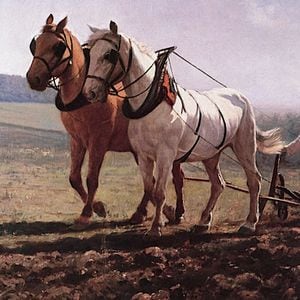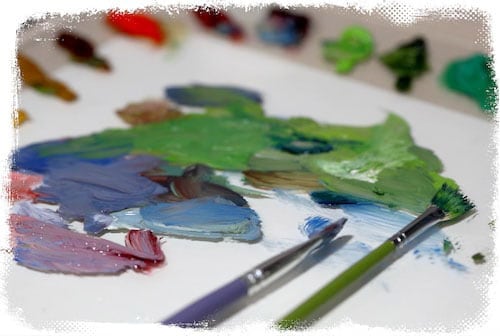
Rosa Bonheur
Rosa Bonheur
61 to 90 out of 120 items
61 to 90 out of 120 items
French painter Rosa Bonheur was well known for her animal portraits. She also did realistic sculpture. There is consensus that Bonheur was the nineteenth century's most preeminent female painter.
Bonheur's sexual orientation was never a secret from anybody. She was in a relationship with American painter Anna Elizabeth Klumpke after being with her companion Nathalie Micas for more than 40 years.
On March 16, 1822, in Bordeaux, Gironde, Bonheur entered this world as the eldest member of a creative family.
When Rosa was eleven years old, her mother, a piano instructor named Sophie Bonheur (née Marquis), passed away. Her landscape and portrait painter father, Oscar-Raymond Bonheur, strongly supported his daughter's creativity. The Bonheur family was devout members of the Christian-socialist cult of Saint-Simonianism, which advocated equal educational opportunities for both sexes. Bonheur had three artistic siblings: the painters Auguste Bonheur and Juliette Bonheur and the sculptor Isidore Jules Bonheur.
Bonheur and her mother and brothers relocated to Paris in 1828 when she was only six years old. Her father had already gone there to set up shop. According to her relatives, she was a challenging kid who struggled to learn to read but spent hours drawing before she could even speak. When she was learning to read and write, her mother had her sketch an animal that began with each letter of the alphabet. The artist said that reading aloud to her mother inspired her interest in sketching animals.
She was a constant source of chaos in the classroom and was repeatedly kicked out of school.
Her father took up her training as a painter after an unsuccessful apprenticeship with a dressmaker when she was twelve years old. When she expressed an interest in painting animals, her father encouraged her to bring real ones into the family's studio so she could study them.
Bonheur started her studies by reproducing pictures from drawing books and sketching plaster models, as was customary for art students at the time. The horses, sheep, cows, goats, rabbits, and other tame animals in the pastures surrounding Paris, the vast fields of Villiers near Levallois-Perret, and the still-wild Bois de Boulogne were studied as her training advanced. She started making copies of artworks at the Louvre when she was just fourteen years old. The works of Nicolas Poussin, Peter Paul Rubens, Paulus Potter, Frans Pourbus the Younger, Louis Léopold Robert, Salvatore Rosa, and Karel Dujardin were among her favorites to imitate.
She learned veterinary dissection techniques at the National Veterinary Institute of Paris (École Nationale vétérinaire d'Alfort) and animal anatomy and skeletal structure at Paris' abattoirs.
During her time there, she completed in-depth investigations that served as the basis for her subsequent paintings and sculptures. During this time, she became friends with Étienne Geoffroy Saint-Hilaire and his son, Isidore Geoffroy Saint-Hilaire, who were both renowned comparative anatomists and zoologists.
Bonheur's first significant achievement, Ploughing in the Nivernais, was shown in 1849 and is currently housed in the Musée d'Orsay in Paris. The French government commissioned the painting.
Her most renowned painting, the Horse Fair, was eight by sixteen feet in size when she finished it in 1855. It shows the Paris horse market on the street de l'Hôpital, which is bordered by trees and is located next to the Pitié-Salpêtrière Hospital. A scaled-down replica may be seen at the National Gallery in London. Because of this accomplishment, Bonheur gained national and worldwide renown; in the same year, she visited Scotland and met Queen Victoria, who was taken with her. While there, she drew inspiration for her subsequent works like 1859's Highland Shepherd and 1860s A Scottish Raid. The Victorians found great attraction in these works because they reflected a way of life that had been lost in the Scottish highlands a century earlier.
At the 1893 World's Columbian Exposition in Chicago, Bonheur showed her artwork at the Palace of Fine Arts and The Woman's Building.
In 1889 and 1890, she became close friends with American artist Cyrus Dallin, who was in Paris for art school. They collaborated to draw Buffalo Bill Cody's Wild West Show's animals and performers. Bonheur painted a portrait of Cody mounted on a horse in 1890. The exhibition of "A Signal of Piece," another early piece by Dallin, took place in Chicago in 1893 and marked a turning point in the artist's career.
She received the French Legion of Honor from Empress Eugénie in 1865 and was elevated to Officer of the order in 1894, despite being more well-liked in England than in her own country of France. The prize was presented to her as a first for a female artist.
Ernest Gambart, an art dealer, acted as Bonheur's agent (1814–1902). His 1855 trip with Bonheur to England, where he bought the rights to reproduce her work, earned him international renown. Charles George Lewis (1808-1880), one of the best engravers of his day, used replicas of Bonheur's work to make several engravings.
As a result of her achievements, she was able to relocate to the Château de By in the suburbs of Paris, close to Fontainebleau, in 1859. A museum honoring her life and work currently resides in her former home.
Female artists of Bonheur's day faced sexism and discrimination on the road to success, but her work helped pave the way for others.
It was healthy knowledge that Bonheur wore men's clothing; she justified her penchant for pants by claiming that they were more functional for her work with animals.
She was in a long-term relationship with American painter Anna Elizabeth Klumpke after her first girlfriend, Nathalie Micas, passed away.
Bonheur was a trailblazer for speaking openly about her sexuality at a period when most French authorities saw lesbianism as animalistic and disordered.
Bonheur defied gender norms by donning pants, shirts, and ties in a society that frowned upon such displays of masculine attire. However, she refrained from doing so in her commissioned portraits or staged images. She didn't do it out of a desire to pass for a man (though she would often refer to herself as a grandchild or a brother when discussing her family) but because she related to the masculine ideals of strength and independence. Bonheur found her true self by publicly demonstrating her rejection of the gender binary as it was constructed by mainstream culture, which was accomplished by her adoption of dressing as a man. It was a clear signal of her sexual orientation at a period when lesbians were often portrayed as having short hair, wearing pants, and smoking constantly. That's three things that Rosa Bonheur accomplished. Although Bonheur never came out as a lesbian, her lifestyle and how she spoke about her female lovers seem consistent with this.
A "Decree regulating the cross-dressing of women" was passed on 17 November 1800, effectively preventing women in France from wearing pants until 2013. This was a problem until at least World War II, although it may still be an issue throughout Bonheur's lifetime. Bonheur liked wearing pants when she went to the sheep and cattle markets in 1852 to study the animals she painted, but she had to get permission from the police.
Bonheur enjoyed things more often associated with males, including hunting and smoking, yet she still considered being a woman an incredible privilege. She spoke of how she had no interest in men other than the bulls she painted since they were so foolish.
She decided to be her employer and rely on herself and her female collaborators rather than on any male figure in her artistic endeavors. She took up the earner role by focusing on her painting while her partners handled domestic duties. Those lesbian artists who didn't want to follow the path society had set out for them had Bonheur's legacy to look up to.
On May 25, 1899, at the ripe old age of 77, Bonheur passed away in the French town of Thomas.
Along with her longtime partner Nathalie Micas (1824–24 June 1889), she was laid to rest at Paris's Père Lachaise Cemetery. Upon Bonheur's passing, Klumpke became her only heir and was buried next to Micas and Bonheur. In 1900, she had a successful auction in Paris when several of her works, which had never been seen, were sold.
Throughout the 20th century, Bonheur and other 19th-century realist painters fell out of favor, with one critic calling Bonheur's Ploughing in the Nivernais "entirely forgotten and rarely dragged out from oblivion" in 1978. That same year, however, the French government sent a series of paintings to China for an exhibition titled "The French Landscape and Peasant, 1820-1905."
Her status has now been restored to some degree.
Rosa Bonheur is the subject of a chapter in Why Have There Been No Great Women Artists? by renowned art historian Linda Nochlin (1971), which is widely regarded as a seminal work in developing feminist approaches to art history and art philosophy.
In 2008, Bonheur's Monarchs of the Forest brought in slightly over $200,000 at auction.
Most paintings Rosa Bonheur did are about Animal, Landscape, People, and other subjects.
Most of the artist's works that can be seen by the public today are now kept in museums like The Wallace Collection - London, Sudley House, Liverpool Museums, Aberdeen Art Gallery and Museums, and others.
Famous Rosa Bonheur period artists include Eugène-Louis Boudin (French, 1824 -1898), Camille Pissarro (French, 1830 -1903), Marianne North (British, 1830 -1890), Vincent van Gogh (Dutch, 1853 -1890), Ivan Constantinovich Aivazovsky (Russian, 1817 -1900), Alfred Sisley (French, 1839 -1899), Paul Cézanne (French, 1839 -1906), Paul Gauguin (French, 1848 -1903), Ivan Ivanovich Shishkin (Russian, 1832 -1898), Isaak Levitan (Russian, 1860 -1900), Winslow Homer (American, 1836 -1910), Albert Bierstadt (American, 1830 -1902), and others.
Get inspired by the most famous paintings of Rosa Bonheur. Pick your favorite, and one of our talented artists will make a copy just like the original, making it a unique gift or piece of art for your home. If you can't find a specific Rosa Bonheur, contact us for a price quote.






























